MENU
MENU
Tea production area: Yame City, Chikugo City, Hirokawa Town, Asakura City, Ukiha City, Miyako Town, Buzen City, Koge Town
Brand: Yame Tea and Hoshino Tea, Yame Dento Gyokuro
Types of tea: Sencha (medium-steamed green tea), fukamushicha (deep-steamed green tea), gyokuro (high quality shaded tea), matcha, kamairicha (pan-fired green tea), kukicha (stem tea), hojicha (roasted green tea), genmaicha (green tea with roasted rice), black tea, bancha, powdered tea, etc.
Yame tea
In Fukuoka Prefecture tea is cultivated mainly in Yame City and the Yame District. Tea cultivated and produced in Fukuoka Prefecture is collectively called Yame tea.
Various types of tea, such as sencha, gyokuro, matcha, bancha are produced. Especially, Yame gyokuro is quite famous.
History
Tradition says that the Buddhist monk Eirin-shuzui went to Ming (China) to study Buddhism and brought back tea seeds to Japan from there in 1406 and planted them in the Reiganji-temple in Kuroki Town, Yame City. Because of this, it is said that the temple became the birthplace of Yame tea.
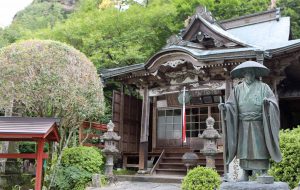
A statue of the Buddhist monk Eirin-shuzen at Reiganji-temple (August 2018)
Yame Central Tea Plantation
Tea fields of around 70 hectares extend over a hilly area in Yame City. The scenery of it is magnificent.
Tourists can visit the tea garden which is about 20 minutes by car from the “Yame Interchange” on the Kyushu Expressway.
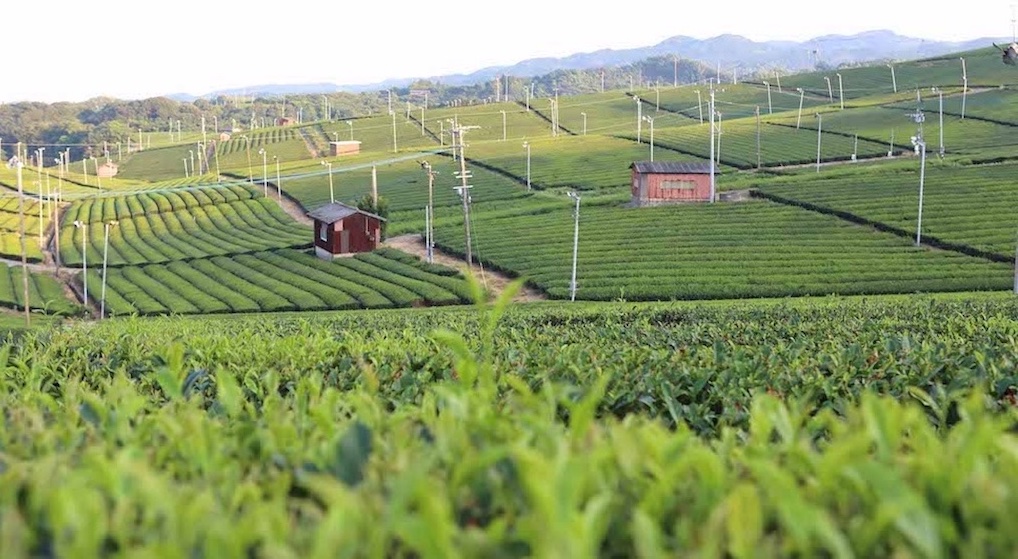
Yame Chuo-daichaen (August 2018)
Yame gyokuro
Yame gyokuro is one of three major gyokuro production places in Japan. The other two are Uji, Kyoto Prefecture and Fujieda, Shizuoka Prefecture.
Gyokuro is high quality steamed green tea. Poles are erected in tea fields, which are then covered with rice straw woven mats or man-made black mats, in order to block sunlight for 2 to 3 weeks before new buds are picked by hand. Gyokuro is produced using only new buds. When sunlight is blocked, catechins (bitterness components) are suppressed and amino acids (umami components) increase. Now there are only a few gyokuro tea farmers who use rice straw woven mats. Covering with straw woven mats is the traditional way, but the weight is more in comparison to man-made black mats. However, the black mats are easier to handle.
The straw woven mat is called sumaki in Fukuoka Prefecture but called komo in Shizuoka Prefecture.
Yame dento hon-gyokuro
Yame dento hon-gyokuro is registered as a Geographical Indication (GI) protection system which is managed by the Japanese government.
Dento means traditional and hon-gyokuro means authentic gyokuro. The system protects registered products as intellectual property when the characteristics of the production area are linked to it such as traditional production methods and the climate of the area. Strict conditions are required for being accepted as Yame dento hon-Gyokuro. For example, the tea leaves must be picked by hand and sumaki must be used, etc.
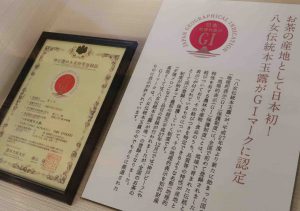
The certificate of GI protection system of Yame dento hon-gyokuro at Chanobunkakan (August 2018)
Chanobunkakan
The Chanobunkakan, is a cultural interactive facility with a shop and restaurant in Hoshino Village, Yame City. Cultivation and production methods of gyokuro are exhibited there. Visitors can experience various tea activities.
In the restaurant, you can drink Yame dento-hongyokuro and eat gyokuro curry and sweets using gyokuro. You can also eat gyokuro leaves with soy sauce or salt after drinking at the restaurant. The leaves are very tender.
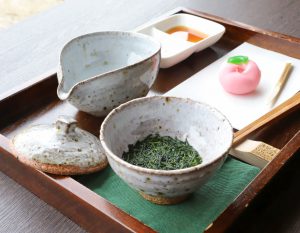
Yame dento-hongyokuro Shizuku at Chabunkakan (August 2018)
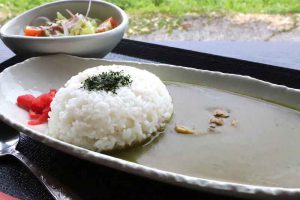
Gyokuro curry at Chabunkakan (August 2018)

Yame matcha cola and Yame black tea sparking (August 2018)
Guest house Sky Tea House
“Tenku no chayashiki (Sky Tea House)” is a guest house in Kuroki Town, Yame City. The owner traveled around the world, then emigrated to Kuroki Town where they opened the guest house.
The guest house is surrounded by tea fields and the owner produces tea. Guests can experience various activities such as picking tea leaves.
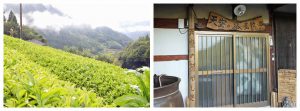
Sky tea house, (August 2018)
Yuino-cha
There is a custom called Yuino-cha in Fukuoka Prefecture and other prefectures in Kyushu.
Yuino is a ceremony of exchanging marriage engagement gifts and Yuino-cha is a tea which is one of those gifts. It is said that the custom of Yuino-cha was introduced to Kyushu from China.
Because roots of a tea plant grow deep into the ground the bride’s family wishes for their daughter to take deep root in her husband’s home.
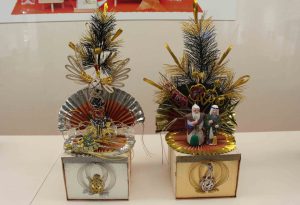
Yuino-cha which was exhibited at a special exhibition in the Tea Museum, Shizuoka (November 2021)
Tea related facilities:
霊巌寺 https://www.crossroadfukuoka.jp/event/?mode=detail&id=400000005702
茶の文化館 https://www.hoshinofurusato.jp/tea/
天空の茶屋敷 Sky Tea House http://www.skyteahouse.com
八女中央大茶園 https://www.city.yame.fukuoka.jp/kanko/4/sightseeingspot/1457320346856.html
Tea mascot Yuru-Chara: やめ茶丸(福岡県茶業振興推進協議会)
Ceramic and pottery art: Koishiwaraya ware
Reference:
松下智 (平成3年) 日本名茶紀行 (初版) 雄山閣出版
高野實・谷本陽蔵・富田勲・中川致之・岩浅潔・寺元益英・山田新市 執筆 (社)日本茶業中央会監修 (2005) 緑茶の事典 改定3版 柴田書店
霊巌寺境内の説明文「霊巌寺の奇岩(福岡県指定天然記念物)黒木町教育委員会」
農林水産省 地理的表示(GI)保護制度 https://www.maff.go.jp
ふじのくに茶の都ミュージアム https://tea-museum.jp
*When visiting the shops and facilities introduced in this article, please check the business hours on their website, etc. before visiting.
*The information provided on this site may be updated. If you find any information in this article that is incorrect, new, or incomplete, please contact CHAMART.
*The site does not describe all “Teas of Japan” or all “Teas of the World”. Additionally, each article expresses the writer’s personal experience and feelings.
#yametea #japanesetea #fukuoka #gyokuro